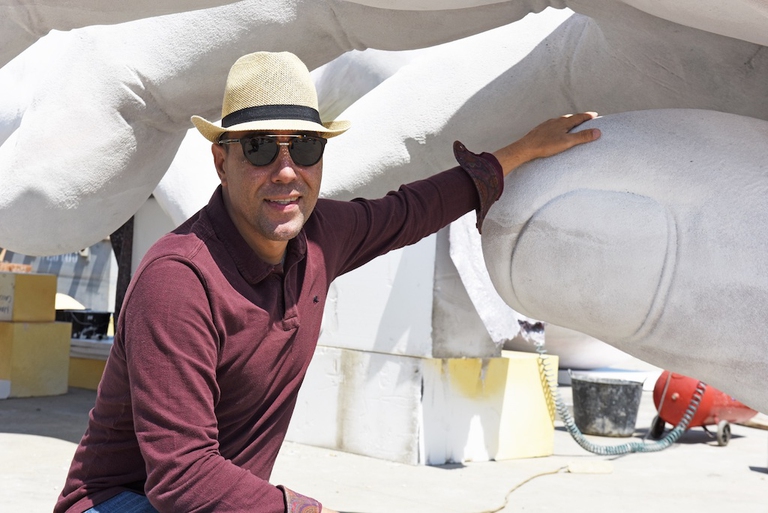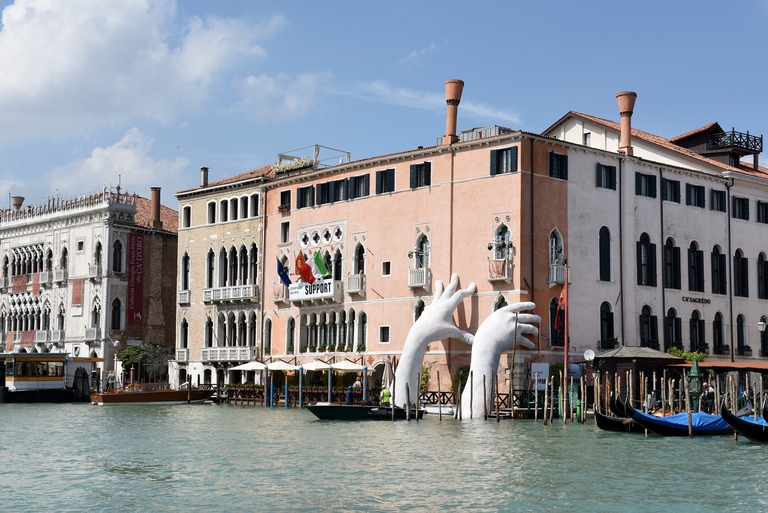
Homecast is a podcast series recorded in quarantine in which creatives from around the world share their lived experiences of these unique circumstances. Creator Giacomo De Poli tells us why this collective diary was needed now more than ever.
Two marble-white nine-metre tall children’s hands surging from the Grand Canal in Venice and ambiguously supporting or toppling over the Ca’ Sagredo hotel have skyrocketed sculptor Lorenzo Quinn to fame. The installation Support has captured the world’s attention with its powerful message about climate change: we have the power to either sustain or destroy our global heritage. Its location
Two marble-white nine-metre tall children’s hands surging from the Grand Canal in Venice and ambiguously supporting or toppling over the Ca’ Sagredo hotel have skyrocketed sculptor Lorenzo Quinn to fame. The installation Support has captured the world’s attention with its powerful message about climate change: we have the power to either sustain or destroy our global heritage. Its location is significant given that Venice itself is facing the prospect of being engulfed by rising sea levels in a not-so-far future and its presence coincides with the Biennale, an international art exhibition that runs until the 26th of November, day in which Support will also end its time in the floating city.
Read more: Venice, Lorenzo Quinn’s hands support the city against climate change
Response to Support has been so warm that Quinn himself “was overwhelmed and humbled by the reaction,” he confesses. “I intended it to be spectacular, that’s why I made it. I was very thankful that the message got through”. Never before in his 30-year career has a piece resonated so widely.
Born in Rome in 1966 to Mexican-American actor Anthony Quinn and Iolanda Addolori, Lorenzo Quinn began sculpting in his 20s. Inspired by masters such as Michelangelo, Bernini and Rodin the representation of the human figure, hands in particular, is central to his work. Not just because of the technical challenge they pose. The intention is to create images that are universal in that anyone can relate to them. His work is “profound, spiritual and existential because it deals with the passions we experience as humans,” in the words of art historian and curator Consuelo Císcar Casabán.
One of the recurring themes in Quinn’s work is that of balance, capturing the dark and light sides of human nature. “It has been a constant in my work, this seek for balance, I guess I’m looking for a balance myself in life,” he reveals. Yet this representation of duality isn’t an expression of neutrality. The message is empowering and optimistic as it points to how our capacity to both create and destroy ultimately is in our hands. Support epitomises this idea: we have all the resources to face the threat of climate change, we just need to decide the course of action we want to take.
Why do you think the piece has been so well received?
It’s a genuine concern we all have: where is this world going? It isn’t from a political perspective, it’s a work of art; visual and visible. Being where it is, it’s so accessible, so available for all to see and comment on.
Support isn’t the first piece you’ve created on the themes of nature and resilience, why are these important to you?
I did The force of nature which was about the tsunami in 2004 [with epicentre off the west coast of Sumatra, in Indonesia]. I’ve done others, a sculpture called Gaia, one called What goes around comes around and now I have a new one which hopefully is going to be presented very soon called Stop playing with the world – it’s about climate change and it’s been donated to Venice. I have another one coming called A better world. A lot of my sculptures have this call, to protect the world. We’re so concerned with politics and wars, yet we’re not concerned about the only world we live in.
What role does art play in highlighting global issues such as climate change?
It reaches different people in a different way, or the same people but in a different way. They say an image is worth a thousand words, so this sculpture creates a strong message. The hands coming out of the water look surreal. But they’re children’s hands so it’s our future: are we drowning our future and our children? Everybody has a social responsibility, I’m an artist and I make art for people. You have to want to make a change in other people’s lives, your children, you want a better world for them. If you have the ability to reach many people, why not use it? Everybody has a responsibility to use their talents for something that goes beyond themselves.
Why did you choose to highlight the theme of climate change now?
It’s a daily reminder: people think that little actions don’t count but little actions done by a lot of people count a lot. And we have to put pressure on our governments to take big actions. The sculpture says we have the power to make a change so we need the will. It’s about the human race, it’s not even about the world because the world will go on existing. If we care about our future we have to treat Gaia much better.
Why is the concept of a universal language important in your artwork?
That’s what art was created for initially. People told stories through images. We know a lot of our history thanks to artwork, everybody is able to understand it through art. As an artist I want to keep on doing that, I like that everyone can see themselves reflected in my work. That’s why when I work on subject matters like this that are so universal I use human figures, I use hands. Because then there’s no barriers, you can’t say who it is, if they’re black, white, red or brown, girl, boy. I want to dialogue with people and if I have things to say publicly I want the public to be able to understand me. That’s one of the reasons I don’t do abstract art, because it’s very personal and open to so many different interpretations.
In this sense your artwork goes against the perception of art as being a niche “for the few”.
I’ve always gone against the current because I never went through the art world. In fact, the hands aren’t actually part of the Biennale. We presented it to the Biennale back in November and they refused the installation. We did it anyway and now it’s actually become the most popular sculpture.
Why do you think the Biennale refused?
Because I’m not part of that art world. I’ve been very lucky and successful thanks to Halcyon Gallery in London. We’ve been able to place monuments all over the world and sell to the most important art collections, not through critics and curators but through the people. Because the people say “I like that piece, I want it because it speaks to me”.
How were you able to construct a sculpture as large as Support that is entirely recyclable?
The material we used is a recyclable foam that can be minced back into powder and reused. The iron structure can be reused as well. The idea now is not to recycle them because we want the sculpture to tour the world. In fact, the UN has placed a call asking people where they think the hands should go next. We’ll see where they’ll go after Venice; another place that needs to draw support and attention. We’ve had fantastic proposals, we’ve had a proposal from the town of Pisa to put the sculpture holding the leaning tower. Although that would be fantastic for social media, I don’t think it would be right because the fact that it’s leaning has nothing to do with climate change. Instinctively, one of the best places would be the Poles, probably on a melting glacier. So maybe do a timelapse, have the hands there initially supporting a glacier and then a year later the glacier not being there with the hands supporting thin air.
What would you like people to take away from Support when they see it?
Hope. Hope for a better world, that we will listen.
Do you think people are reacting to the sculpture that way?
Maybe at first they don’t. At first it’s great, people smile. Then it’s awe, then wonder, then concern. In the end it becomes hope – I hope.
Siamo anche su WhatsApp. Segui il canale ufficiale LifeGate per restare aggiornata, aggiornato sulle ultime notizie e sulle nostre attività.
![]()
Quest'opera è distribuita con Licenza Creative Commons Attribuzione - Non commerciale - Non opere derivate 4.0 Internazionale.
Homecast is a podcast series recorded in quarantine in which creatives from around the world share their lived experiences of these unique circumstances. Creator Giacomo De Poli tells us why this collective diary was needed now more than ever.
Time magazine’s 100 Women of the Year project sheds light on influential women’s stories, from Amelia Earhart to Greta Thunberg. A selection of some of the greats for International Women’s Day.
Leaving cliches behind, beauty and sexuality in old age are widely unexplored topics. Photographer Arianne Clément tells why she chose to shed light on this universe.
Un violador en tu camino – the rapist is you – is an anthem protesting the impunity of gender-based violence. It began in Chile and has become a global flash mob, bringing people to the streets and resonating all over the world.
The Oxford English Dictionary has chosen “climate emergency” as 2019’s Word of the Year because of its effectiveness in communicating a sense of urgency in the fight against global warming.
Filmmaker Dhondup Wangchen was imprisoned by the Chinese government for his documentary condemning the Tibetan condition. He tells us how he continues to fight for his people even after the traumas faced.
To mark the release of Anthropocene: The Human Epoch, we interviewed photographer and co-director Edward Burtynsky, who told us the story behind the documentary.
Snowflakes can be deceiving. Banksy transformed them from a marker of winter festivities into a symbol of the plague of air pollution in his mural Season’s greetings in Port Talbot, Wales.
Artist Jeff Hong imagined how Disney fairy tales’ characters would live in the real world: the result – or better the ending – is everything but happy.









